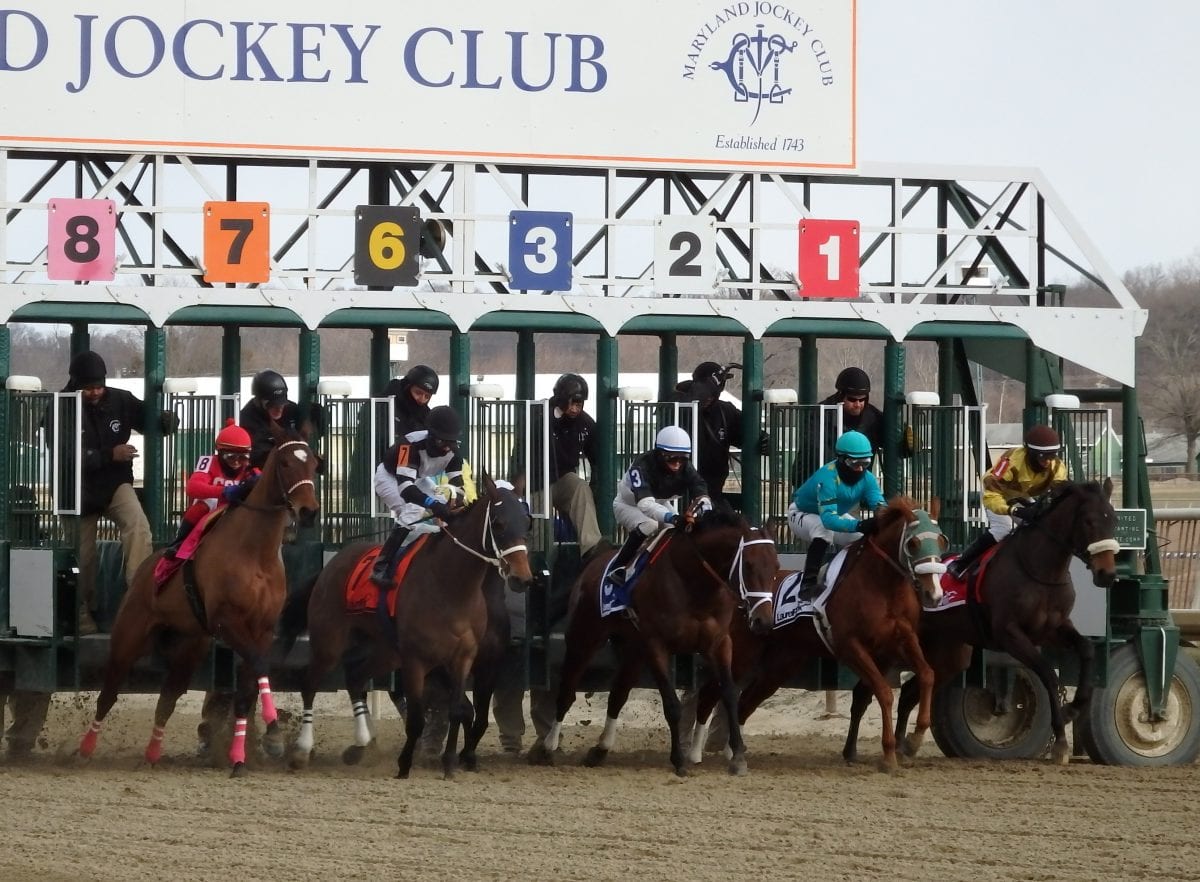In Maryland, a search for “happy middle” in racing program

by Frank Vespe
Daily News ran in a starter allowance on December 12 for trainer Katy Voss. The next two times Voss entered the horse at Laurel Park, the track didn’t use the race. Finally, reluctantly, she entered him against tougher company on January 31 – only to have him get injured a day before the race.
Andiemac, then a two-year-old, broke her maiden on July 24 at Laurel Park for trainer Jerry Robb. Yet the Maryland-bred daughter of Outflanker didn’t start again in her home state until December 11. “I entered every time, but it never went,” Robb said. “It always got bumped.”
And one day in late March, trainer Mike Trombetta spoke with resignation of his efforts to enter horses. “I put in seven horses yesterday, and only two got in,” he said.
The plight of these horses – all trained up with nowhere to go – is a common lament among Maryland horsemen and, indeed, in these days of tough competition for a shrinking horse population, around the region.
In fact, Andiemac’s problem finding a race has brought Robb before the Maryland Racing Commission at least three times since late last year. And his complaints are echoed by many Maryland horsemen.
The problem, they say, is particularly acute now that turf season is upon us: too many turf races and too many low-level maiden and claiming races on the dirt. Exacerbating the problem, they say, is the difficulty of figuring out which races the track will use – and managing their stables properly as a result.
Left behind are middle-priced claiming horses who have run through their lifetime conditions, two-year-old winners, and horses “that are better than claiming horses but not quite stakes horses,” according to Trombetta: those that need third- and fourth-level allowances, or money allowances, on the main track.
“Last summer if you had a dirt horse, it never went unless you had a cheap horse,” said Donald Barr, another veteran of the Maryland backstretch and a board member of the Maryland Horse Breeders Association. “You couldn’t run a horse for two months.”
“Every card [over the summer] was turf, $5,000 or maidens,” Robb agreed. “So every other horse we had in the barn never got a chance to run. It’s all tunnel vision – what has the most horses, instead of looking over the fence and seeing what horses haven’t run in a while and keeping them here.”
“You have this problem everywhere [in the mid-Atlantic]: trying to predict what races go and don’t go is a difficult exercise,” added Trombetta, a member of the Maryland Thoroughbred Horsemen’s Association (MTHA) board of directors who has strings both at Laurel Park and at Fair Hill, granting him a level of flexibility not available to those stabled at the track.
The numbers seem to lend credence to the horsemen’s concerns.
In one recent three-day period in the mid-Atlantic, Laurel, Parx Racing, Penn National, and Charles Town carded a total of 106 races. They chose those races out of a total of 243 races listed in their condition books and as extras on their overnights.
That means that less than 44 percent of the eligible races went in those three days. Put a different way, the tracks drew for a bit more than two races for every race they let go.
And now, with turf season approaching full swing, about half of the races that Laurel Park has carded in recent days have been on the lawn. What’s more, Maryland Jockey Club president Sal Sinatra has indicated his intention to run as many as six grass races per day when racing returns to Laurel for the summer stand.
That’s a scary prospect, Barr says.
“You’ll have fix or six on the turf, and three $5,000 races a day,” he predicts. “You as a stable cannot survive on that. Your owners are going to lose too much money.”
Indeed, in one representative weekend from last summer, the Maryland Jockey Club carded 13 turf races versus 11 on the dirt. Of the 11 dirt races, four were $5,000 claiming events, and two were bottom-level maiden races. As a result of the quality skew, the average purse of the grass races was more than 15 percent higher than the average for the dirt contests.

A COMPLEX BALANCING ACT
Each day, racing secretaries around the country craft their upcoming cards. They pull the races that will fill, say, your favorite track’s Friday afternoon card from two sources: the condition book, which typically includes more than a full card’s worth of races, plus a handful of substitutes; and extra races that are included on the track’s overnight sheet.
It’s a complex balancing act the racing office has to perform. On the one hand, the track needs big fields to attract wagering in an increasingly competitive marketplace.
At the same time, however, it also needs to have a varied and interesting program. Run too many bottom-level races, even with full fields, and the track can gain a bad reputation among fans and bettors.
The Maryland Jockey Club has made yeoman efforts over the last couple of years to increase field size and raise wagering, and it has done so with considerable success.
The average field size in Maryland grew to 8.5 horses per race in 2015. That was up substantially from the 7.7 runners per event in 2014, and it was the highest in the state in at least the last 20 years, according to The Jockey Club.
That’s had a similarly positive impact on the company’s handle. Handle on the company’s live product grew 20 percent in 2015 versus the prior year.
Sal Sinatra, president and chief operating officer of the Maryland Jockey Club, attributed the growth in handle to several factors, including, “bigger, more competitive fields.”
Moreover, he told the Maryland Racing Commission April 19, handle on the company’s export signal – that is, bettors outside of Maryland playing the Maryland product – was up another 20 percent through the first two months of 2016. What’s more, the MJC has added racing dates to the 2016 schedule — the first time in years that Maryland added days.
But management and the fans aren’t the only constituents the racing office has to placate. It also has to make sure that the trainers and owners whose horses populate the backside feel like there is sufficient opportunity to run.
Horsemen typically aren’t shy about expressing their displeasure when things get out of whack – “It happens every year,” Maryland Jockey Club racing secretary Georganne Hale says of the grousing — but the issue is more than one of preference. When horses can’t run, owners get restive, and when owners get restive, business dries up.
“It’s let alone frustrating for the trainer,” said Barr. “When you train and don’t run, the frustration is for the owner who’s paying the bills. It broke a lot of people, and a lot of people left the business.”
Trombetta agreed. “People don’t like to sit on the sidelines for two months — that’s a six- or seven-thousand-dollar penalty.”
And when people leave the business, or scale their operations back, that further compromises the track’s ability to draw horses and fill cards – a vicious cycle.
Even when the horses do get in, horsemen say, the uncertainty of the schedule poses challenges. Take Voss’s Daily News. She had entered him for races on December 27 and January 11, she said, prior to the January 31 entry. That meant she had to keep him at essentially peak readiness for an entire month hoping for a race to go, which can be hard on the horse, some trainers say.
“That’s one of the biggest problems people don’t see, from a trainer perspective,” pointed out Trombetta. “When you don’t know when your run date is, it’s pretty hard to train the horse. That’s not the way you would have trained him if you knew you were going to run in June rather than April.”
Added Robb, “This is what I try to get [the racing office] to understand: it’s hard to train horses not knowing what month you’re going to run.”

THE ROOT OF THE PROBLEM
How did these challenges come to be?
At one level, the Maryland and other mid-Atlantic tracks are feeling the same pinch as every other track in America.
“The root of the problem is there’s just not enough horses for the racing that’s being offered,” Trombetta suggested.
He’s right, of course. Nationally, the foal crop in the last couple of years has been about half of what it was 25 years earlier. Moreover, the average number of starts per runner per year has also fallen. That’s a tough combination for any racetrack.
The number of horses that made at least one start in the US and Canada last year – 53,365 – was the smallest since at least 1975, according to The Jockey Club.
In all, even though the number of races contested has dropped 47 percent since 1990, field size has still dropped. Fewer horses starting, and making fewer starts per year, mean that in 2015 the number of starts made was 54 percent lower than it had been in 1990.
To Voss, who serves on the Maryland Thoroughbred Horsemen’s Association’s condition book committee, the challenge is clear.
“Everybody keeps beating up on the condition book, but the real problem is we have a horse shortage,” she said. “You don’t have enough people bringing young horses into the system.”
The industry, she added, has “to come up with more ways to make it attractive to go to the sale and buy yearlings.”
But that’s a long term solution. In the meantime, Andiemac, Daily News, and dozens of other horses need to race – to keep their owners in the game long enough to bring some of those young horses to the track.
Perhaps the key issue in Maryland, several trainers said, is that the track’s truncated, three-day-a-week schedule and its full-sized condition book simply don’t mesh with each other.
“The biggest problem with the whole thing is that horsemen are used to having 45 races a week,” said Ferris Allen, an MTHA board member and a trainer in Maryland since the 1970s. “Now they have 27. So the question is, What changes do you make in your condition book to make that work?”
Voss agreed. “The problem here is we’re only racing three days a week,” she pointed out.
And the problem with that, Voss and others said, is that with just 27 races per week on average to fill, the track doesn’t have to use – and rarely does – the kinds of races that draw six or seven entries, which often are higher level allowances.
“It’s the same index [of races] as when we ran five days a week,” said Robb. “Now we only run three. That’s the whole problem.”
The three-day-a-week schedule came about in part because of the shrinkage of the Maryland racing product in recent years and in part because, last year, the track and MTHA agreed — with the support of most around the track — to add summer racing to the schedule while removing some dates elsewhere in the year.
The proliferation of available conditions for horses, particularly at lower levels, is another issue putting strain on the horse population.
“Years and years ago everything was open,” said Laurel Park racing secretary Georganne Hale, who wistfully recalls her days at Bowie, when “we used to split races three or four times.”
Back then, once a horse broke its maiden, it immediately had to find its way in open claiming ranks or to move up through the allowance conditions.
These days? Some tracks write so-called “lifetime claiming races” – that is, for horses that have not win a specified number of times in their lives – all the way up to “never-won-five.” And starter races with various lifetime conditions have proliferated around the region.
The first condition book for Pimlico Race Course features no fewer than five different conditions for horses that have never won two races: an allowance, three claiming, and a starter/optional claiming. It also includes a couple of races at both the never-won-three and never-won-four levels.
Hale and her boss, Maryland Jockey Club president and chief operating officer Sal Sinatra, say that they have no choice but to card a wide variety of often exotic and confusing conditions because their competition – the region’s other racetracks – is doing the same.
“I have to write them to keep my horses from racing out of town,” Hale said.
That’s good news for people looking to bring young horses along because it means more chances to run against similarly experienced and talented company.
But it puts increased pressure on a horse population that’s already stretched thin. Everyone feels that pinch, and it may be most acute here in the mid-Atlantic where, in the heart of the summer racing season, seven different tracks will be competing for horses.
FINDING THE “HAPPY MIDDLE”
Where does all of this leave horsemen?
Sinatra sees the problem and says that it requires a regionwide solution.
“Foal crop is down, and inventory has shrunk, but the number of conditions has expanded,” he pointed out. “You’re creating a model that’s going to get short fields. We all get into that stupid mode where you’re chasing horses.”
He went on, “Racing secretaries are combining these conditions to fill cards. The only way to change it is to get everybody on the same page.”
That means, he said, that secretaries would need to agree, for example, to stop writing lifetime conditions above, say, never-won-three, and to get rid of “double beaten” conditions (haven’t won two in a specified time period).
Yet in an industry as divided, and dog-eat-dog, as horse racing, the prospects for such an accord are uncertain. Once Monmouth Park and Delaware Park open next month, Pennsylvania, Delaware, New Jersey, Maryland, and West Virginia will be home to seven different tracks owned by six separate entities. The Maryland Jockey Club’s reported efforts to take charge of the racing at Parx Racing offer some cause for optimism, but there’s still a ways to go.
Robb, for one, suggests that in the meantime, the Maryland jockey Club should focus on developing and dominating a market niche: eliminating certain categories, becoming the region’s top track in those that remain, and leaving the lower claiming market to Charles Town and Penn National.
“The only way to cut the categories is either to cut them out of the bottom or cut them out of the top,” he suggested. “I would never say cut from the top. Tell your trainers and owners in Maryland that we’re going to cut back and eventually we’re going to cut these races out. So in the meantime, take your horses wherever you need to to race them and get rid of them and upgrade. Get a little better horse because that’s the program we’re going to have, but give us time to prepare.”
To a certain extent, Allen, the MTHA board member, agrees. “You have to simplify things,” Allen agreed, “and you have to craft your condition book so none of your horse population gets excluded.”
Among the changes he recommends are reducing the range of lifetime claiming conditions. He also suggests at least occasionally carding the first-level allowance as an optional claiming race, with a $12,500 or $16,000 tag. That, he argues, would enable the track to card more first allowance races, thus creating more first allowance winners and setting the stage for more higher level allowance contests, as well. Others, however, fear that such a move would make these races yet harder to win and further hinder the financial viability of young horses.
Barr thinks that one key step this coming summer will be to run more than eight or nine races per day and to use some of the shorter field races – the third- and fourth-level allowances and mid-priced claimers on the dirt. That way, he said, you can still run six turf races and a representative number of lower level dirt races with full fields, while also taking care of the better stock on the grounds. With the purse account having closed a substantial shortfall over the last year, that might be possible.
“Financially, the purse account is going to be in a lot better position to run summer racing,” Barr said. “In my mind you can’t run eight races a day. You have to run 11, 12 races a day. The track has got to let some of the dirt races with six or seven horses go.”
He went on, “The health and welfare of the backside has to be considered in this, and right now because of the way we’re going, the health and welfare of this backside is hurting. Somebody’s got to look after the Maryland guys. There has to be a happy middle.”
In the longer run, Barr says, he would like to see representatives from the MTHA, the MJC, and the Maryland Horse Breeders Association — a group that typically has not had much input on the composition of the racing program — “sit down at a table and work this issue out.”
Sinatra says he hears the horsemen and wants to find that happy middle.
“I’m going to make a conscious effort to use an equal number of dirt and turf races this summer,” he said. “We’re moving in the right direction. The next step is to make sure the book is keeping our horses here. You have to be conscious of the horses on the grounds and make sure they start.”








Great, great article Frank. I can’t say how enlightening it is.
Thanks, Horseman – much appreciated.
Very well done.
Frank,
That was very formative. A lot of work too; thank -you. I guess Md.-bred races will really take a back seat now. And I hate to be a told you so guy…. but I told you Tap Diva would win when she went long! Thanks again.
Bill
I totally agree about 10/11 race days in Maryland. Is it possible to go to $300,000 (excluding stakes races) a day in purses any time soon? I don’t mind 7 horse fields that are competitive. To think that with a shrinking horse population, having trouble finding a race for your horses makes no sense to me? But then I’m just a bettor and not a trainer/owner in Maryland. Very informative article Frank.
Since all tracks in the Midatlantic area are facing horse shortages why not coordinate condition books amongst the tracks and allow free flow of horses between them. Delaware, MD, PA, and WV all have policies restricting stabled horses from racing outside their respective venues but all eagerly take the entries from out-of towners. Makes no sense whatsoever.
Your readers might be interested in viewing the letter signed by Sal SInatra and given to all trainers in Maryland recently which threatened the loss of stabling if horses raced out of town. MD horsemen pay for stabling and building of new barns (but the dollar amount remains a secret) which I believe is the only horsemen’s group in the country to do so. The tone of the letter was enough to p**-off even the most tolerant of owners. Might we see a link somewhere to this? Facebook perhaps?